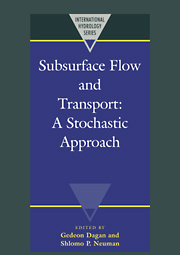Book contents
- Frontmatter
- Contents
- List of contributors
- Preface
- Acknowledgments
- I INTRODUCTION
- II SUBSURFACE CHARACTERIZATION AND PARAMETER ESTIMATION
- III FLOW MODELING AND AQUIFER MANAGEMENT
- IV TRANSPORT IN HETEROGENEOUS AQUIFERS
- 1 Transport of inert solutes by groundwater: recent developments and current issues
- 2 Transport of reactive solutes
- 3 Nonlocal reactive transport with physical and chemical heterogeneity: linear nonequilibrium sorption with random rate coefficients
- 4 Perspectives on field-scale application of stochastic subsurface hydrology
- V FRACTURED ROCKS AND UNSATURATED SOILS
- VI A VIEW TO THE FUTURE
1 - Transport of inert solutes by groundwater: recent developments and current issues
Published online by Cambridge University Press: 04 December 2009
- Frontmatter
- Contents
- List of contributors
- Preface
- Acknowledgments
- I INTRODUCTION
- II SUBSURFACE CHARACTERIZATION AND PARAMETER ESTIMATION
- III FLOW MODELING AND AQUIFER MANAGEMENT
- IV TRANSPORT IN HETEROGENEOUS AQUIFERS
- 1 Transport of inert solutes by groundwater: recent developments and current issues
- 2 Transport of reactive solutes
- 3 Nonlocal reactive transport with physical and chemical heterogeneity: linear nonequilibrium sorption with random rate coefficients
- 4 Perspectives on field-scale application of stochastic subsurface hydrology
- V FRACTURED ROCKS AND UNSATURATED SOILS
- VI A VIEW TO THE FUTURE
Summary
ABSTRACT Some recent developments in stochastic modeling of transport of inert solutes are discussed. Rather than tabulating all that has been done, we focus on some central issues. We explore the attempts to depart from the limited model for dispersion of the mean concentrations toward a complete stochastic description, and continue by evaluating the means for narrowing the ensemble of all physically plausible realizations toward the one which will eventually become a reality. We discuss some scaling issues: starting from the relationship between the scale of the plume and the scale of the heterogeneity, and ending by analyzing the behavior of finite plumes in domains with evolving scales of heterogeneity. We conclude by exploring the issue of the concentration variability. The limitations of the two-moment characterization are evaluated, and we present a method for computing the entire concentration probability distribution function (pdf) as well as some recent ideas on how to use tracer data for Bayesian updating of the concentration moments.
INTRODUCTION
Application of the stochastic paradigm to the problems of contaminant transport in porous media has been a major center of research activity over the last few years. This surge of activity reflects the growing recognition of this concept as a viable problem solving tool, as well as the increase in the efforts to solve environmental problems.
It is not the goal of this chapter to take stock of all that has been achieved in recent years. The alternative pursued here is to identify and analyze some central areas of activity within the discipline with a view toward recording problems that were resolved or became better understood, as well as others that still await resolution.
Information
- Type
- Chapter
- Information
- Subsurface Flow and TransportA Stochastic Approach, pp. 115 - 132Publisher: Cambridge University PressPrint publication year: 1997
Accessibility standard: Unknown
Why this information is here
This section outlines the accessibility features of this content - including support for screen readers, full keyboard navigation and high-contrast display options. This may not be relevant for you.Accessibility Information
- 15
- Cited by
